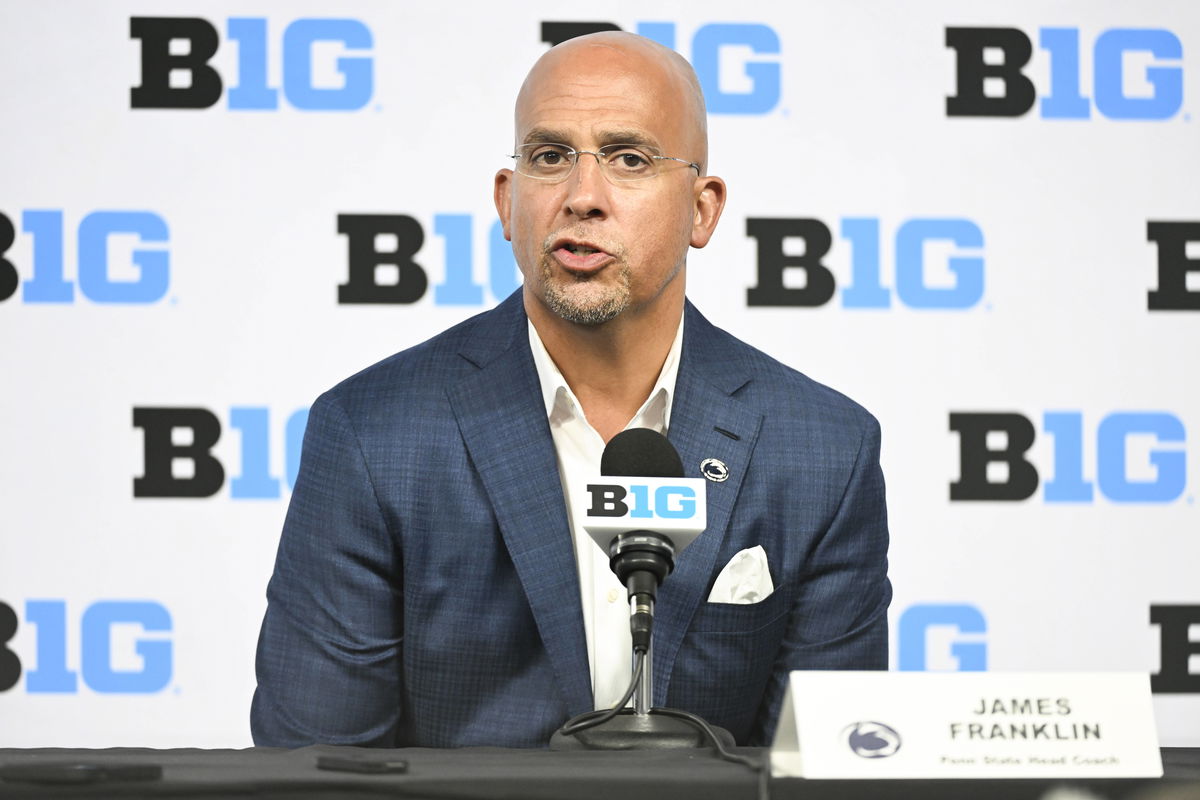
Imago
NCAA, College League, USA Football: Big Ten Football Media Days Jul 24, 2024 Indianapolis, IN, USA Penn State Nittany Lions head coach James Franklin speaks to the media during the Big 10 football media day at Lucas Oil Stadium. Indianapolis Lucas Oil Stadium IN USA, EDITORIAL USE ONLY PUBLICATIONxINxGERxSUIxAUTxONLY Copyright: xRobertxGoddinx 20240724_gma_ga3_0770

Imago
NCAA, College League, USA Football: Big Ten Football Media Days Jul 24, 2024 Indianapolis, IN, USA Penn State Nittany Lions head coach James Franklin speaks to the media during the Big 10 football media day at Lucas Oil Stadium. Indianapolis Lucas Oil Stadium IN USA, EDITORIAL USE ONLY PUBLICATIONxINxGERxSUIxAUTxONLY Copyright: xRobertxGoddinx 20240724_gma_ga3_0770
On a picture-perfect day, Penn State’s powerhouse performance against Nevada had the crowd buzzing with excitement. The Nittany Lions dominated the game with a 46-11 margin, snagging their first win of the season. Following that impressive blowout, James Franklin took to the media room at Beaver Stadium with a calm and reflective presence. He praised standout performances. But amid the post-game glow, Franklin also shared a familiar frustration bubbling under the surface. It’s the dilemma over college football scheduling. Franklin has been outspoken about his disdain for the Big Ten’s nine-game conference schedule for years, calling it “the worst decision the Big Ten ever made.”
Watch What’s Trending Now!
Franklin’s main gripe is about fairness and uniformity. Last year, Penn State made it all the way to the Big Ten Championship game against Oregon. That extra high-stakes game meant the Nittany Lions played more total games than many of their playoff rivals, who didn’t have to play a conference title. The consequence? More wear and tear for the players, more chances for injuries, and undoubtedly, more fatigue heading into the College Football Playoff. Because of that, some teams get to play a conference championship game while others don’t. And even Ryan Day echoed the same emotion. “When you play nine conference games, it’s not the same as someone who plays eight conference games,” Day said.
The SEC played eight conference games a year, while the Big Ten and Big 12 rolled with nine. Franklin’s plea is, “Everybody should have conference championship games. There should be consistency. Again, if you want to try to put together the best 12 teams for a playoff, it’s hard to do that when you have a committee getting together and trying to compare eight conference games to nine conference games to conference championship games and, you know, one team loses a conference championship game, another team doesn’t even have to play in one.” Now, with the SEC announcing in August 2025 that it will join the Big Ten and Big 12 by adopting a nine-game conference schedule starting in 2026, the college football landscape gets a similar stage.
ADVERTISEMENT
Penn State head coach James Franklin on the SEC moving to 9 conference games.
Clarifies he is not attacking any team in particular. pic.twitter.com/plYrQGqW5A
— Collin Ward (@wardcollinz) September 1, 2025
Now, the two conferences have already adopted the same standard. For years, the SEC stood firm with an eight-game slate while asserting its strength, but the shift now brings the Power 4 leagues onto a more comparable footing. The uniformity in conference games removes one of the biggest scheduling headaches. That means every SEC team will face a heavier in-conference grind. Plus, the league is mandating a 10th game against another Power 5 opponent or Notre Dame. This ups the ante for SEC teams – meaning they will have a minimum of 10 really tough games every year, like those of the Big Ten and Big 12. SEC Commissioner Greg Sankey highlighted that this change underscores a major commitment.
“Adding a ninth SEC game underscores our universities’ commitment to delivering the most competitive football schedule in the nation,” Sankey said. “This format protects rivalries, increases competitive balance, and, paired with our requirement to play an additional Power opponent, ensures SEC teams are well prepared to compete and succeed in the College Football Playoff.” Before, it was like trying to compare apples to oranges every season. Now it levels the playing field, especially when it comes to evaluating teams for the College Football Playoff. Suddenly, the committee can compare teams more fairly because their resumes will be built on similar schedules.
ADVERTISEMENT
The economic boom of SEC football
Starting in 2026, the SEC will roll out a nine-game conference schedule—a massive financial power move wrapped in helmets and turf. For years, SEC teams filled non-conference schedules with easy “cupcake” games, letting the big fish win. Those predictable blowouts failed to thrill fans or boost TV ratings, but they poured millions into the pockets of the smaller schools visiting. Like Texas A&M shelling out over $3.7 million for its 2025 non-conference slate. Now, all that changes.
ADVERTISEMENT
By adding a ninth conference game, the SEC scrapes away the throwaways and cranks up the heat on every Saturday. Think marquee matchups like Alabama vs. LSU or Florida vs. Georgia is becoming more frequent and meaningful, boosting stadium attendance and national TV ratings. More high-stakes games mean better content for the SEC’s multi-billion-dollar broadcast partners like ESPN, which locked down exclusive rights to SEC football starting in 2024 in a massive $3 billion deal over ten years.
This new nine-game schedule will give ESPN up to 15 premium SEC games a year on ABC and ESPN+. Also, numerous streamed non-conference games, driving ratings, ad revenue, and streaming subscriptions through the roof. Financially, each added game could be worth an additional $5 million or so per SEC school annually. That totals the sum to hundreds of millions over the contract term. It means bigger ticket prices. Also, game-day experience is now a premium with prices soaring to upwards of $130 or more for average tickets and even higher for prime matchups.
ADVERTISEMENT
ADVERTISEMENT
ADVERTISEMENT

